How to Fish Electrical Wire Through Walls With Insulation
Fishing Electrical Wire Through Walls
Run electrical cable through walls and across ceilings without tearing them apart by fishing wire
1 / 15
 Family Handyman
Family Handyman
Check the Whole Wall Cavity With a Stud Finder
2 / 15
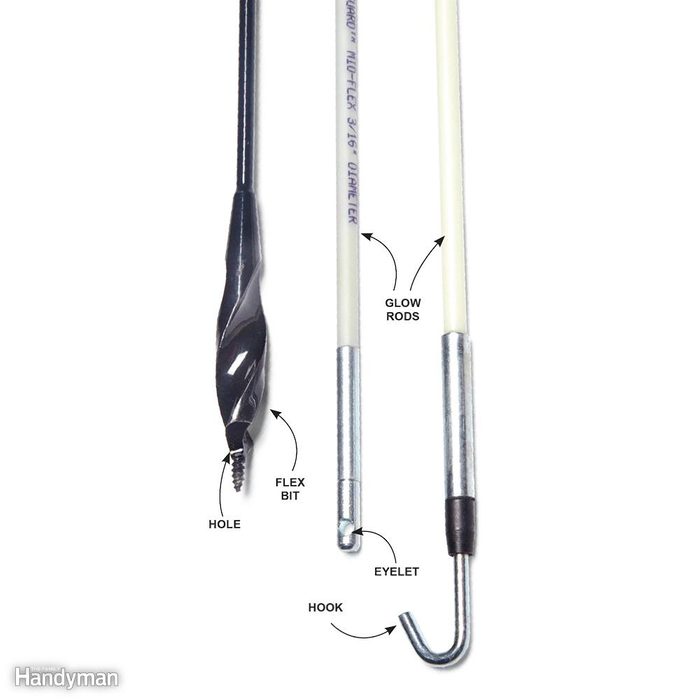 Family Handyman
Family Handyman
The Tools You Need
Flex bits and glow rods are the go-to tools pros use for fishing wires. Flex bits are great for drilling holes in hard-to-reach spaces (see "Invest in a Bumper Ball," below). The two most common lengths are 5 ft. and 6 ft., but extensions are also available. A 3/4-in. x 54-in. flex bit costs about $50 at home centers. Buy a bit that has a hole on the end of it so you can use the bit itself to pull wires. Once your hole is drilled, you can shove a glow rod through the hole to start fishing wire, attach your wire to the eyelet at the end and pull it back through. Glow rods can also be used to hook wires to pull them out as a wire snake tool. As their name suggests, glow rods glow in the dark. This makes them easier to spot when you're working in dark areas fishing wire (which is most of the time). Glow rods come in various lengths and thicknesses, and you can combine as many sections as the job requires. Thinner rods flex more and work better when you have to make sharp turns when fishing wire. A thicker rod can span longer distances and is better for hooking wires that are more than a few feet away. A 9-ft. glow rod kit costs about $40 at home centers. Expect to pay about $60 for a 24-ft. kit. Don't forget an electrical tester.
3 / 15
Get more tips for fishing wire and cable through a finished wall in this video:
4 / 15
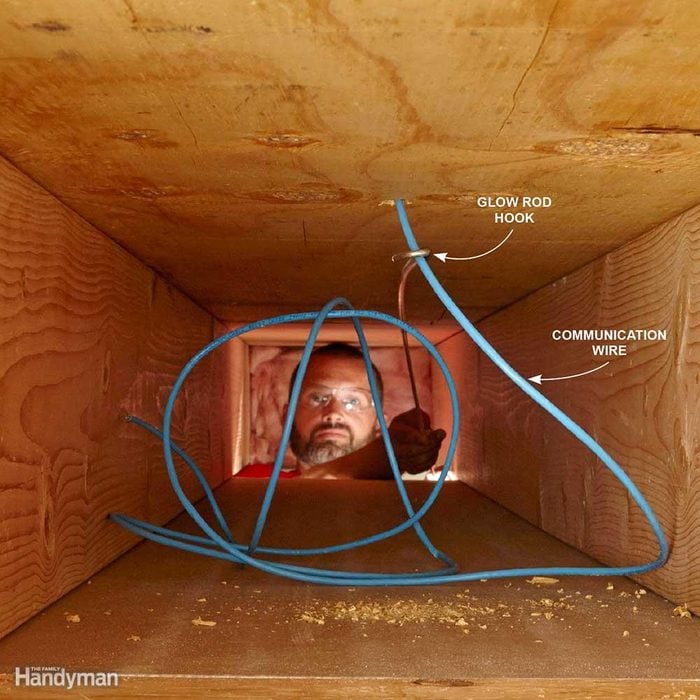 Family Handyman
Family Handyman
Push Through More Than You Need
When fishing wire to pull it toward you, make sure there's more than enough wire to hook on to. Sometimes it's a real challenge to grab hold of a wire, and once you have it hooked, you don't want to lose it. Always makes sure that you have at least 5 or 6 ft. of extra wire to keep up the tension on the hook the whole time you're pulling on it.
5 / 15
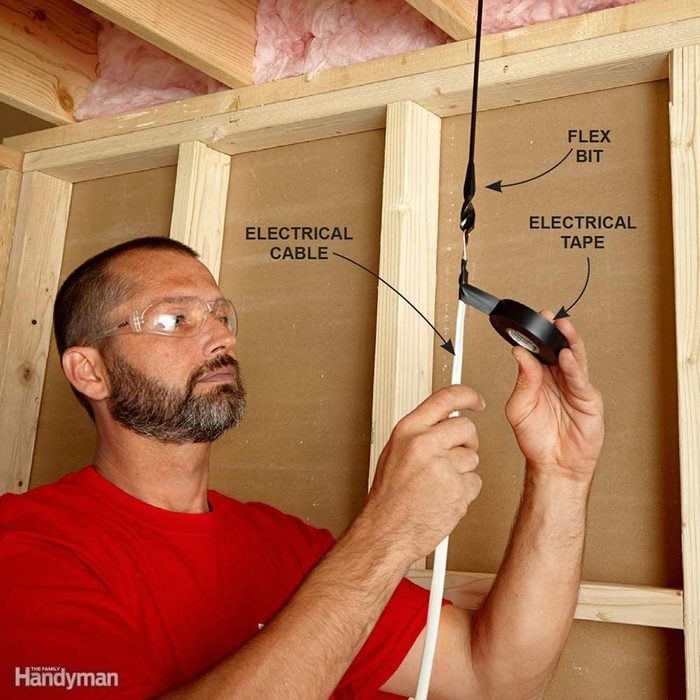 Family Handyman
Family Handyman
Hook on to a Flex Bit
Sometimes you don't need to use glow rods at all when fishing wire. Most flex bits have holes in the ends of them, perfect for fishing wire. If you have access to where the flex bit pops out, attach your wire directly to the bit and fish the wire through that way. Twist the wire and tape it up to make sure it doesn't come off when you're pulling it back through. Remove your bit from your drill before pulling so you don't accidentally spin the bit and twist up your wire.
6 / 15
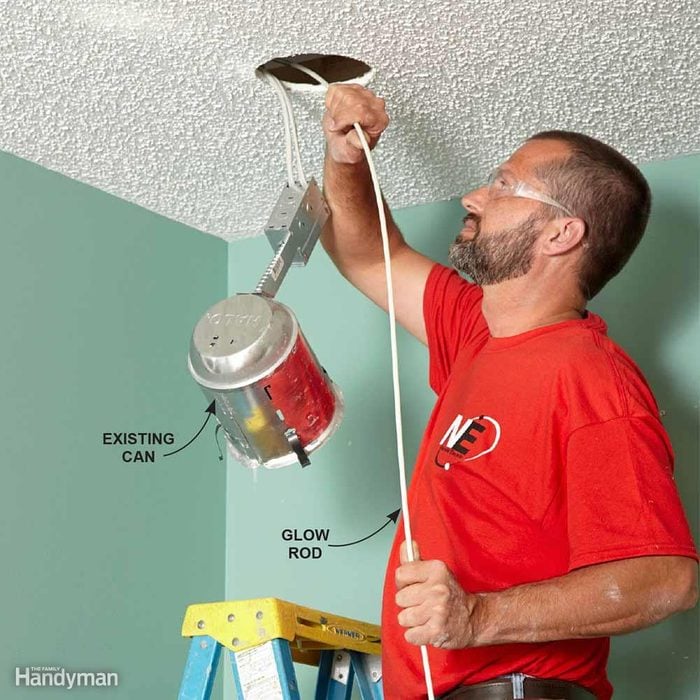 Family Handyman
Family Handyman
Fishing Wire Through the Holes for Recessed Lights
7 / 15
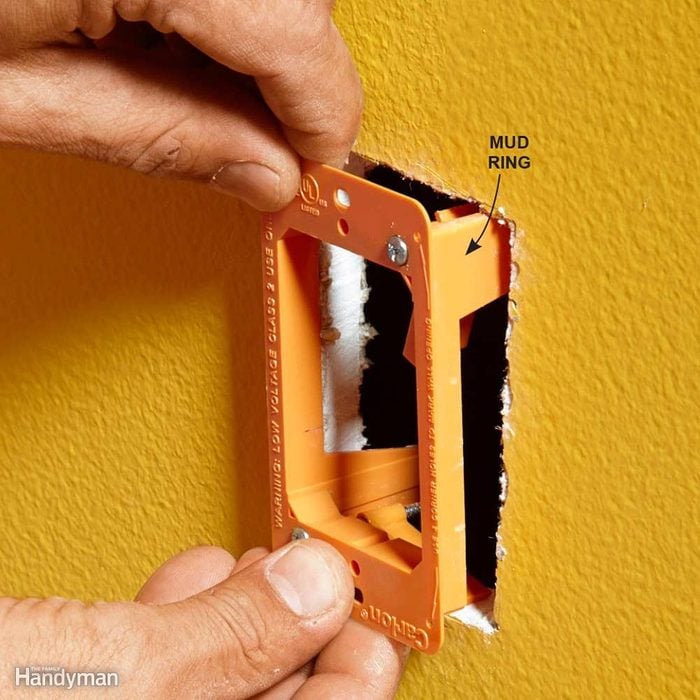 Family Handyman
Family Handyman
Protect Drywall With a Mud Ring
Mud rings, also called drywall brackets or low-voltage "old-work" brackets, are great for protecting the drywall when you're drilling with a flex bit or cranking on a glow rod. They're easy to install (just tighten two screws) and inexpensive. Once the wires are connected, you can screw the wall plate to the mud ring. Mud rings are approved only for low-voltage wires like communication and coaxial cables. If you need to install a regular gang box for an electrical receptacle or wall switch, install the mud ring temporarily to protect the drywall while you fish the wire, then remove it. Check out nine more tips for DIY electrical wiring.
8 / 15
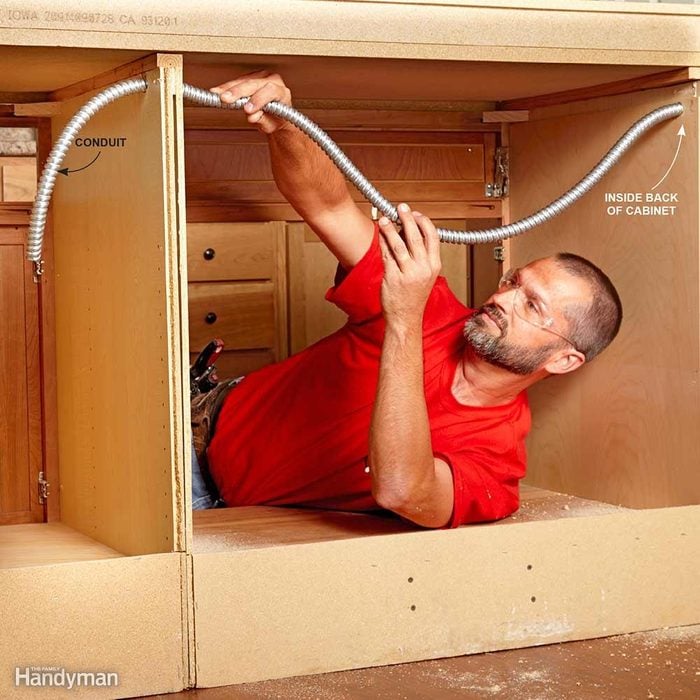 Family Handyman
Family Handyman
Install Conduit Inside Cabinets
9 / 15
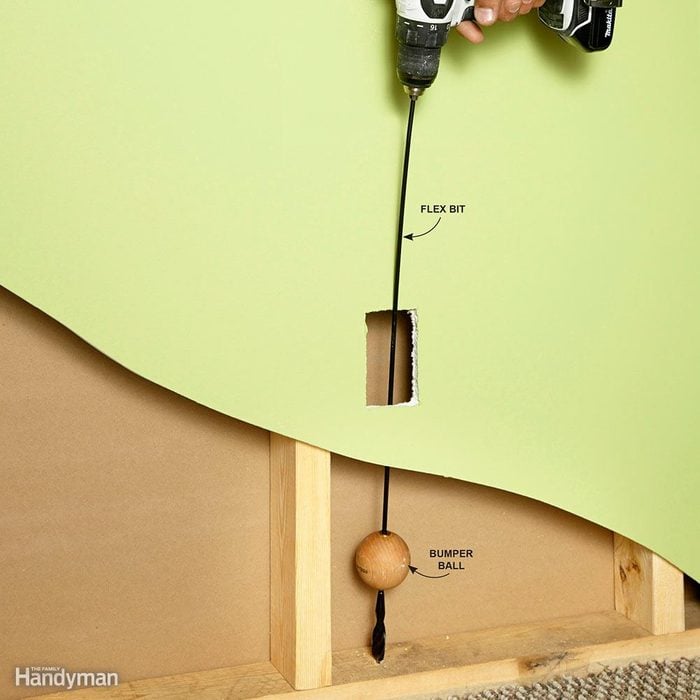 Family Handyman
Family Handyman
Invest In a Bumper Ball
Wires aren't supposed to be installed any closer than 1-1/4 in. from a penetrable surface (the outside of the drywall). That means you shouldn't be drilling holes right next to the drywall. But it's not always easy to control where a flex bit goes. A Bumper Ball flexible drill bit guide installed on the end of your flex bit will help maintain the proper space between the bit and the outside of the wall cavity. You can buy a set of two at electrical suppliers or at licensedelectrician.com.
10 / 15
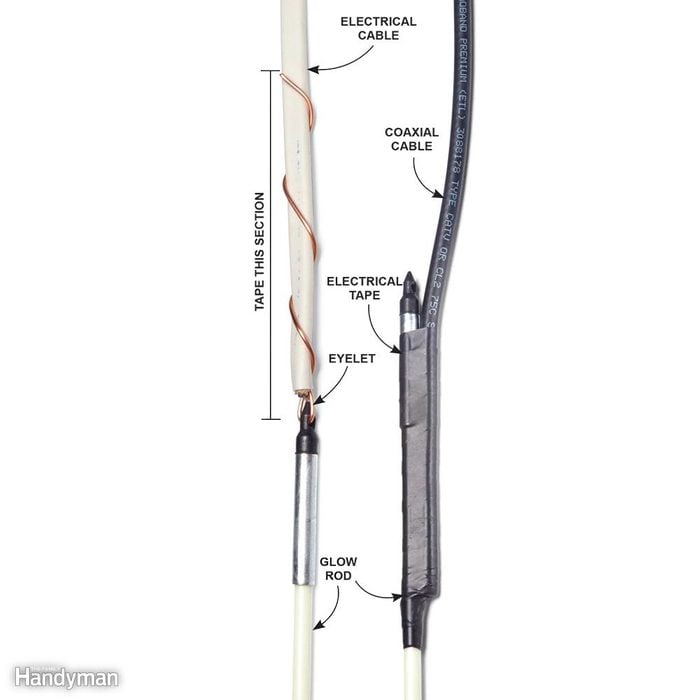 Family Handyman
Family Handyman
Hold on Tight
When you hook cable to the eyelet of a glow rod, strip the plastic sheathing back about 6 in., then cut off the hot and neutral wires. Then wrap the remaining ground wire through the rod's eyelet and wrap it back around the wire's sheathing several times. Finally, wrap the whole area with electrical tape. When hooking coaxial cable, just tape the whole wire to the glow rod. You'll never lose a light wire just using tape. Use the same technique when working with communication cable like phone wire. If you try to hook one of the small communication wires, you could stretch and damage that individual wire several feet down inside the sheathing. Avoid these 10 common electrical mistakes homeowners make.
11 / 15
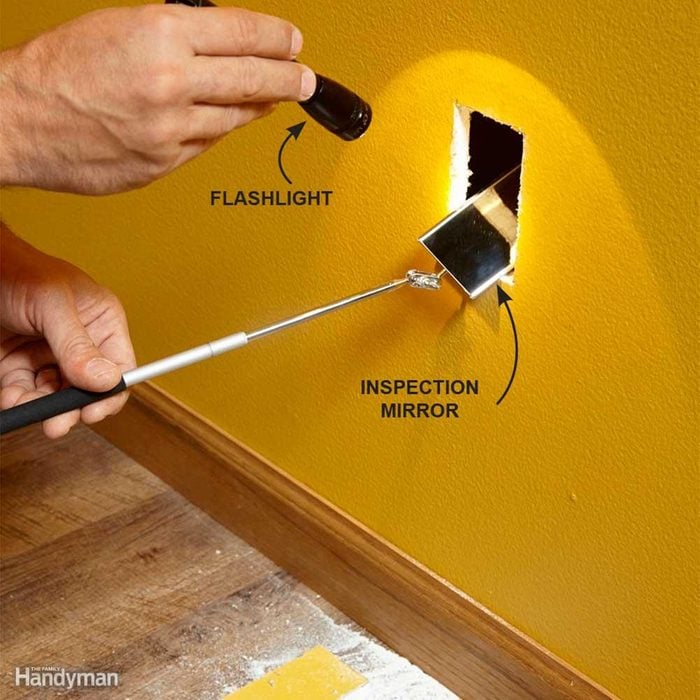 Family Handyman
Family Handyman
Get a Better View With an Inspection Camera
You know your wire is in there somewhere, but you just can't seem to find it. It's probably hung up on another wire or pipe, but guessing isn't going to solve the problem. Instead, shine a flashlight onto an inspection mirror to find out exactly what's going on. This is a simple, inexpensive tip that can save you a lot of time and frustration. Pick up an inspection mirror at an auto parts store for less than $10. Or bump it up a notch and pay a few more bucks for a mirror with small built-in lights, so you can see exactly what's going on.
Don't fret if you've come up short with your wire. The video below will give you tips on how to fix a short wire situation.
12 / 15
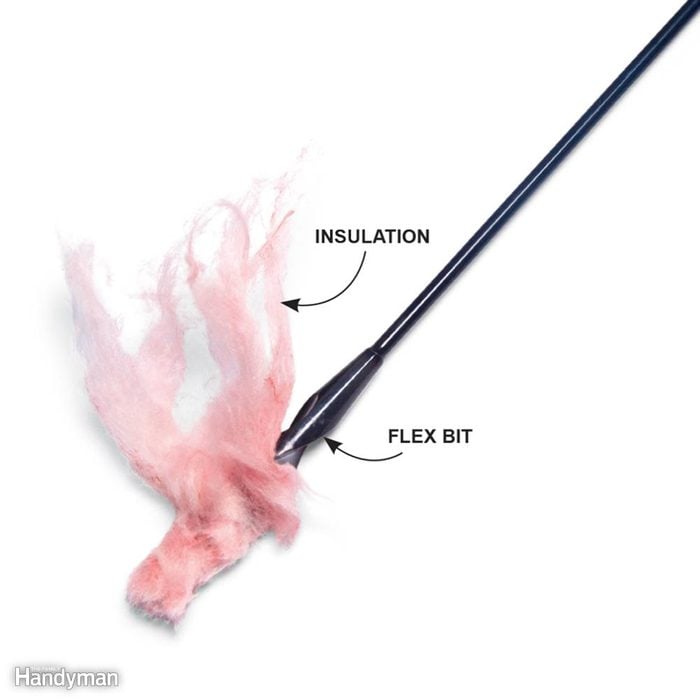 Family Handyman
Family Handyman
Don't Spin the Bit In Insulation
The best advice for fishing wires through insulation is "Avoid it if you can." The potential is always there to damage the vapor barrier or bunch up insulation, leaving cold spots in the wall. If you must fish wires through exterior walls, the best tip is to avoid spinning the flex bit until you make solid contact with the wood you plan to drill through. If you drill too early, you'll end up creating a large insulation cotton candy cone, which will make retrieving your bit difficult, if not impossible. Plus: Check out 25 things you need to know about insulation.
13 / 15
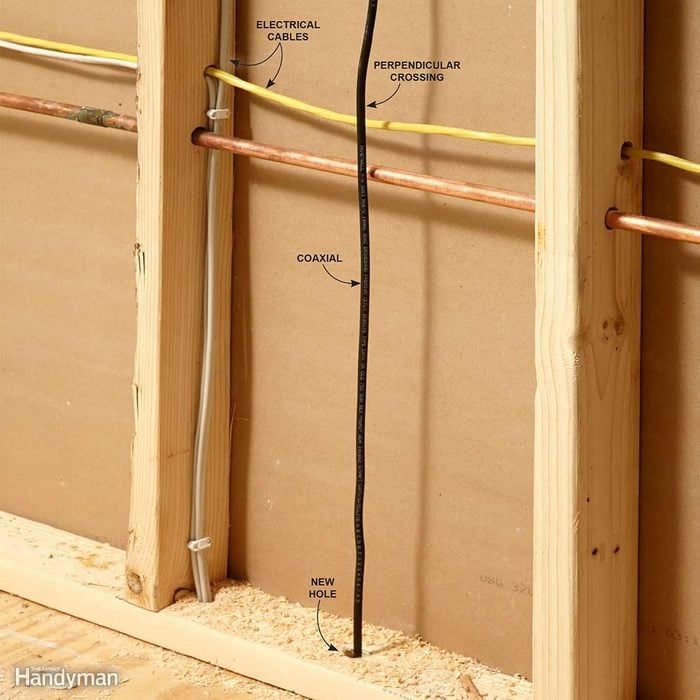 Family Handyman
Family Handyman
Keep Low-Voltage Wires Away From Electrical Cables
It's really tempting to fish low-voltage wires (like coax and Cat-5e) through existing holes occupied by electrical cables, but don't do it! Even though cables are insulated, the high-voltage current can interfere with the signal in the low-voltage wires. This could result in bad TV reception or unreliable phone and Internet service. Drill a new hole, and keep the new low-voltage wire several inches away from electrical cables. It's OK to run low-voltage wires perpendicular to cables, and it's also OK to run low-voltage wires next to electrical wires that are encased in conduit or metal sheathing.
14 / 15
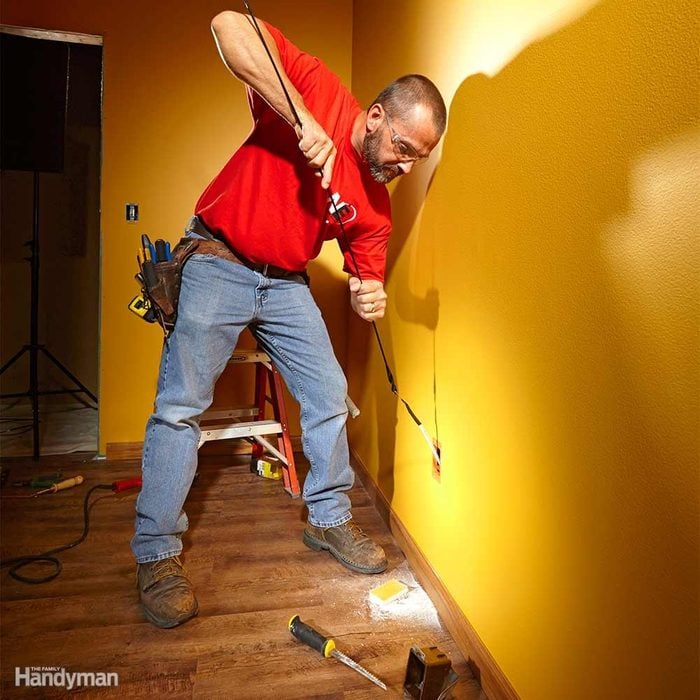 Family Handyman
Family Handyman
Buy Extra Wire
Have plenty of extra wire or cable on hand, because it's not likely that you'll be able to fish a wire in a straight line from Point A to Point B. There's also the possibility that your wire might get hung up on something, and you'd have to abandon it and start over.
15 / 15
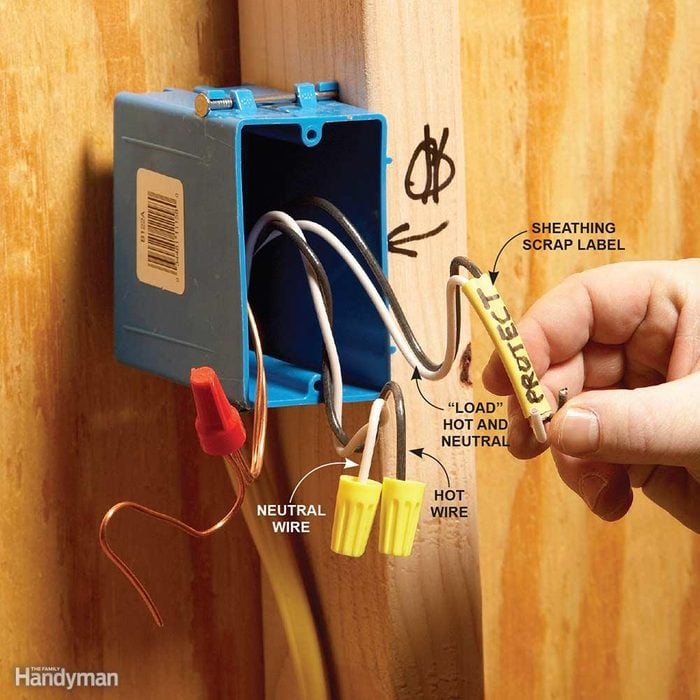 Family Handyman
Family Handyman
Identify Roughed-In Wires
If you're installing more than one wire, save yourself a lot of headaches by identifying the wires as you install them. It's a lot harder to figure out which wires go where when they're covered with drywall. The electricians we talked to use a "code" for marking wires, and so can you. Develop a system and write it down. You don't want to have to guess after you've gone through all the trouble of running the wires all around the house.
Originally Published: December 14, 2018
Sign up for DIY projects sent right to your inbox
Complete DIY projects like a pro! Sign up for our newsletter!

Subscribe & SAVE 1 Year Subscription
for only $10!
How to Fish Electrical Wire Through Walls With Insulation
Source: https://www.familyhandyman.com/list/fishing-electrical-wire-through-walls/